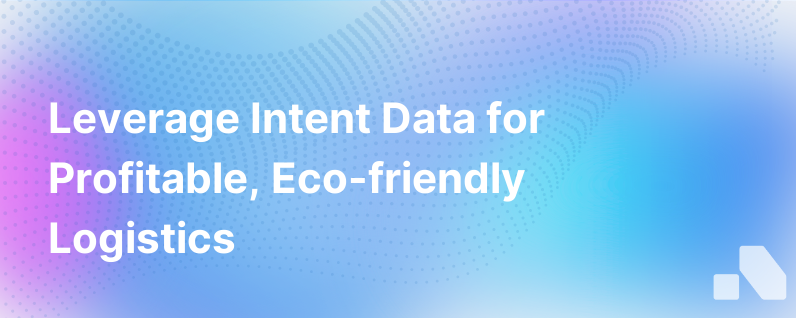
In the dynamic and competitive landscape of shipping and logistics, companies are on a perpetual quest to optimize operations. One key challenge they face is the efficient use of cargo space, which poses not only logistical issues but also significant environmental concerns. Operating partially filled trucks leads to wasted fuel and a larger carbon footprint, not to mention diminished profits. This is where the strategic application of intent data comes in as a game-changer.
Intent data refers to insights derived from the aggregate analysis of actions taken by a user connoting a future intent to act in a certain way. For a logistics company, this might mean using data analytics to forecast when and where goods will need to be transported, thus ensuring trucks are fully utilized. Intent data empowers logistics companies by equating fuller loads with higher profits and reduced environmental impact.
Let's break down how intent data accomplishes this, as well as the benefits it brings to shipping and logistics.
Forecasting Demand with Precision
For logistics, demand forecasting is the cornerstone of optimizing truckloads. Intent data allows for much more than just looking at historical patterns; it provides a glimpse into future needs, enabling companies to predict when and where goods will need to be shipped. By tapping into data points such as browsing behavior, search queries, social media engagement, and purchase history, logistics firms can determine which regions are likely to need more cargo space, thus allowing for strategic truck loading that maximizes space utilization.
Dynamic Route Optimization
Once you have a clearer understanding of where shipment demands are going to increase, you can orchestrate dynamic route optimization. With the aid of intent data, logistics managers can adjust routes in real-time, redirecting trucks to where the real-time demand is peaking. This reduces deadhead (traveling with an empty load) and aids in filling the trucks to capacity, leading to increased revenue per trip and less fuel wastage.
Enhanced Customer Experience
Intent data also can significantly improve the customer experience by tailoring logistics services to the real needs of the market. By analyzing and responding to intent signals, you can predict and respond to customer needs, often before the customer has even made a direct request. This proactive approach ensures that your trucks are not just fuller, but also carrying goods that are in demand, leading to faster deliveries, increased customer satisfaction, and the potential for repeat business.
Streamlined Supply Chain Management
Supply chains are intricate systems that can benefit immensely from predictive data analytics. Intent data helps in visualizing the supply chain requirements ahead of time, allowing logistics companies to align their strategies accordingly. This streamlined management leads to avoiding overstocking or stockouts, ensuring that warehouses have precisely what's required to load trucks optimally, thus reducing unnecessary trips.
Reduction of Environmental Footprint
Perhaps one of the most crucial impacts of utilizing intent data in logistics is the positive environmental repercussions. Improving truck fill rates means fewer trips are required to transport the same amount of goods. This reduction in trips translates directly into fewer emissions, as the biggest source of carbon in logistics is fuel consumption. By optimizing routes and loads, logistics companies can make significant strides in their sustainability goals.
Strategic Partnership and Network Optimization
Intent data does not just foster insights on a company level; it can be instrumental in forming strategic partnerships. By sharing intent data across companies and platforms, logistics firms can engage in co-loading practices, where complementary goods from different companies can share truck space, leading to even higher load optimization.
In addition to subsequent profitability growth, these networking tactics foster a collaborative logistics environment that maximizes resource utilization and accelerates the industry's movement toward green practices.
Leveraging Intent Data Effectively
How can logistics companies effectively leverage intent data? First, it demands the implementation of robust data analytics practices and the integration of sophisticated AI tools. Investing in the right technology suite is essential to gather, analyze, and translate the data into actionable insights.
Next, logistics companies must foster a data-driven culture. The workforce needs to be trained to interpret and trust the insights gained from intent data. Creating a culture that embraces the utility of data analytics ensures more seamless operational transitions predicated upon the intelligence provided by intent data.
Furthermore, companies must prioritize data security and privacy measures. Since intent data often involves handling sensitive information, ensuring privacy compliance and data security is paramount.
Conclusion
In the quest for fuller trucks, higher profits, and a reduced environmental impact, intent data stands out as an invaluable resource for shipping and logistics companies. By tapping into the predictive power of intent data, these firms can not only transform their operational efficiency but also help lead the charge in reducing the industry's environmental footprint.
As sustainability becomes increasingly crucial and customers demand more accountability, those who harness the power of intent data will find themselves at a significant competitive advantage. Intent data is more than just a tool for business optimization; it's a pathway to a more sustainable and profitable future in logistics. When strategically applied, it bridges the gap between economic and environmental objectives, paving the way for growth that does not come at the cost of our planet.